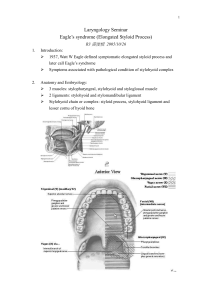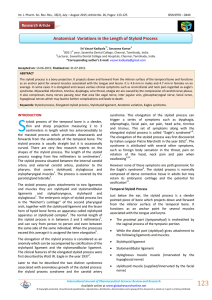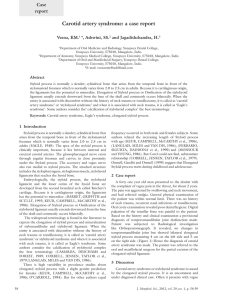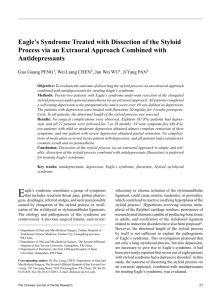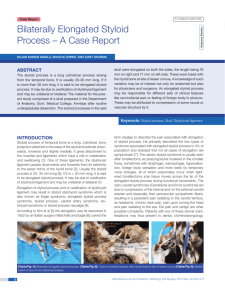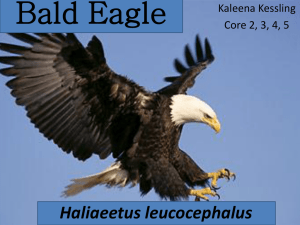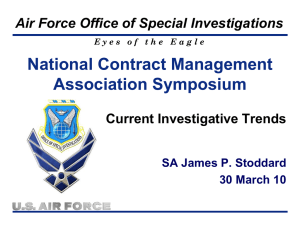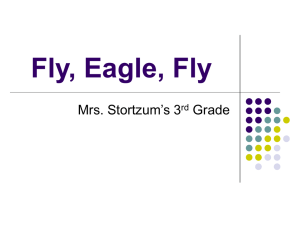Introduction Styloid process is slender needle like pointed projection
advertisement
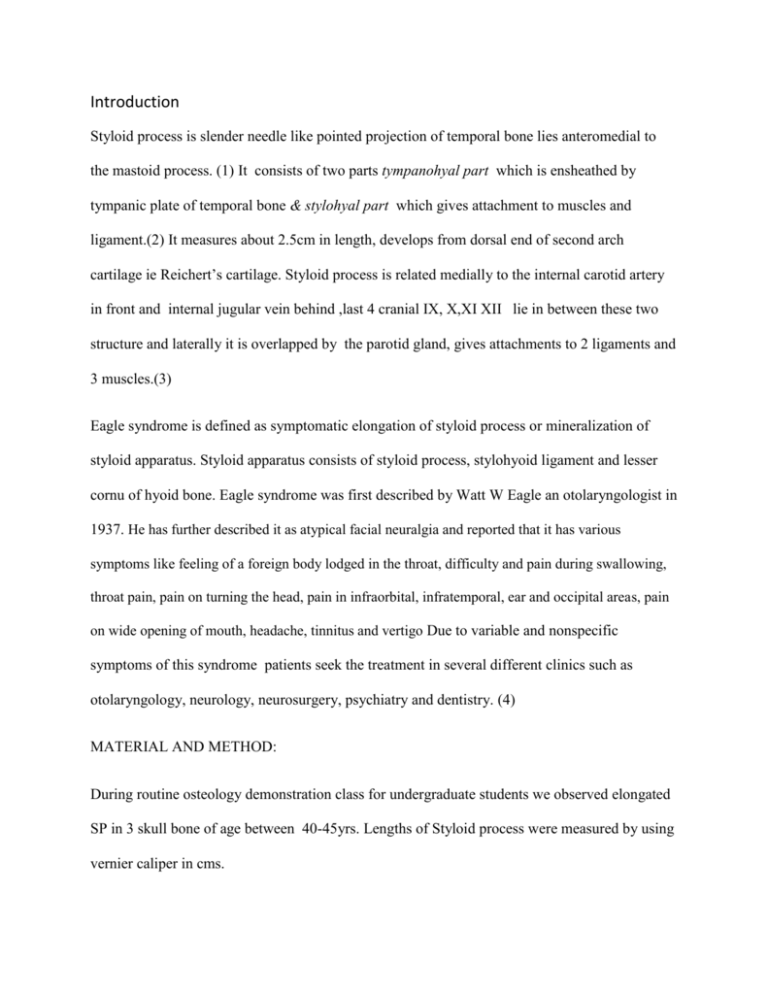
Introduction Styloid process is slender needle like pointed projection of temporal bone lies anteromedial to the mastoid process. (1) It consists of two parts tympanohyal part which is ensheathed by tympanic plate of temporal bone & stylohyal part which gives attachment to muscles and ligament.(2) It measures about 2.5cm in length, develops from dorsal end of second arch cartilage ie Reichert’s cartilage. Styloid process is related medially to the internal carotid artery in front and internal jugular vein behind ,last 4 cranial IX, X,XI XII lie in between these two structure and laterally it is overlapped by the parotid gland, gives attachments to 2 ligaments and 3 muscles.(3) Eagle syndrome is defined as symptomatic elongation of styloid process or mineralization of styloid apparatus. Styloid apparatus consists of styloid process, stylohyoid ligament and lesser cornu of hyoid bone. Eagle syndrome was first described by Watt W Eagle an otolaryngologist in 1937. He has further described it as atypical facial neuralgia and reported that it has various symptoms like feeling of a foreign body lodged in the throat, difficulty and pain during swallowing, throat pain, pain on turning the head, pain in infraorbital, infratemporal, ear and occipital areas, pain on wide opening of mouth, headache, tinnitus and vertigo Due to variable and nonspecific symptoms of this syndrome patients seek the treatment in several different clinics such as otolaryngology, neurology, neurosurgery, psychiatry and dentistry. (4) MATERIAL AND METHOD: During routine osteology demonstration class for undergraduate students we observed elongated SP in 3 skull bone of age between 40-45yrs. Lengths of Styloid process were measured by using vernier caliper in cms. RESULTS: Lengths of Styloid process were measured by using vernier caliper in cms.(table no-1) Figure 1, 2& 3 shows skulls with elongated SP DISCUSSION: SP is slender, cylindrical bony projection from the base of temporal bone lies anteromedial to the mastoid process, varies from 2-3cm in length. (5) Styloid apparatus develops from second or hyoid arch (Reichert’s cartilage) .Dorsal part of this cartilage gives rise to SP & stylohyoid ligament and ventral part to the lesser cornu of the hyoid bone.(6) Eagle defined the length of SP as 2.5-3cm.the normal length of SP varies greatly as fallows From1.52-4.77cm according to Moffat et all in 1977 Less than 3cm according to Kauffman et all From 2-3cm according to Lindeman et all in 1985 Lesser than 2.5 cm according to Carrel et al Less than 4cm according to Monsur According to Balcioglu 2009 mean length of SP of subjects reporting to Eagle syndrome is reported to be 40 +/- 4.7 mm.(7) The cause of elongation of SP is a still topic of debate, is not been fully elucidated till now. There are several theories for elongation of SP. Lentini (1975) formulated the hypothesis that persistence of the mesenchymal elements (Reichert cartilage residues) could undergo osseous metaplasia as a consequence of trauma or mechanical stress during the development of the styloid process.(8) Epifanio (1962) considered that the ossification of the styloid process was related to endocrine disorders in women at menopause, accompanied by the ossification of ligaments elsewhere (eg, iliolumbar, thyrohyoid).(9) Gokce C et all reported that ectopic calcification might have a role for the elongation of SP especially in patients with abnormal calcium, phosphorus and vitamin D metabolism as in end stage renal disease.(10) An elongated styloid process occurs in about 4% of the general population, while only small percentages of these patients are symptomatic,with a female-to-male predominance of 3:1. Bilateral involvement is quite common but does not always involve bilateral symptoms. No significant difference is detectable between the right and left sides. In 1937, Eagle described 2 possible clinical expressions attributable to elongated styloid process. The “classic Eagle syndrome” is typically seen in patients after pharyngeal trauma or tonsillectomy, and it is characterized by ipsilateral dull and persistent pharyngeal pain, centered in the ipsilateral tonsillar fossa, that can be referred to the ear and exacerbated by rotation of the head. A mass or bulge may be palpated in the ipsilateral tonsillar fossa, exacerbating the patient’s symptoms. Other symptoms include dysphagia, sensation of foreign body in the throat, tinnitus, or cervicofacial pain. The “second form” of the syndrome (“stylocarotid syndrome”) is characterized by the compression of the internal or external carotid artery (with their perivascular sympathetic fibers) by a laterally or medially deviated styloid process. It is related to a pain along the distribution of the artery, which is provoked and exacerbated by rotation and compression of the neck. It’s not correlated with tonsillectomy. (7) CONCLUSION: Eagle’s syndrome though the incidence is 4 to 7%, it is largely under diagnosed,elongated styloid process should be kept in mind when patient comes with complaint of recurrent neck pain, odynophagia. Careful palpation of SP in tonsillar fossa along with radiography (Towne’s view) will confirm the diagnosis of elongated styloid procedure. REFERENCES 1. Moore KL,Dalley AF, Agur MR. Clinically oriented Anatomy.6th ed. New Delhi. Wolter Kluwer:2010. 2. Johnson D, Ellis H, Collins P, Standring S, editor. Gray's anatomy: the anatomical basis of clinical practice.39th ed. 90 Touttenham court road London W1T 4LP: Elsevier Churchill Livingstone; 2005. 3. Chaurasia BD. Styloid apparatus—deep structures in the neck. In: Chaurasia BD, editor. Human anatomy, regional and applied dissection and clinical. Volume 3, Head, neck and brain. 4. New Delhi: CBS Publishers; 2004. 4. Chandramani B. More and Mukesh Khemchand Asrani Eagle’s Syndrome: Report of Three Cases. Indian J Otolaryngol Head Neck Surg. 2011 October; 63(4): 396–399 5. Holinshead WH: Anatomy for Surgeons .The Head and Neck. Philadelphia, JB Lippincott Co, 1982, 3rd Edition, Volume-1, 308 and 396. 6. Langman’s Medical Embryology. Lippincott Williams and Wilkins, Co. T.W. Sadler, 10th Edition 2006; 261. 7. Eagle WW: Elongated styloid process: Symptoms and treatment. Arch Otolaryngol 1958; 64:172176. 8. Lentini A. Gli aspetti clinici e radiologici delle anomalie dell'apparato stilo-joideo. Radiol Med. 1975; 61:337-3640. 9. Epifanio G. Processi stiloidei lunghi e ossificazione della catena stiloidea. Rad Prat. 1962; 12:127-132. 10. Gokce C, Sisman Y, Sipahioglu M. Styloid Process Elongation or Eagle's Syndrome: Is There Any Role for EctopicCalcification?. Eur J Dent. Jul 2008; 2:224-8. SP- Styloid process Table no -1 skull Right(cm) Left(cm) A 4.6 4 B 4 4.3
